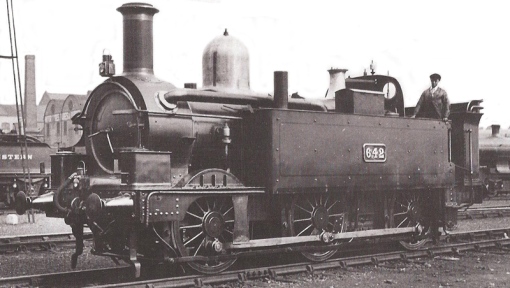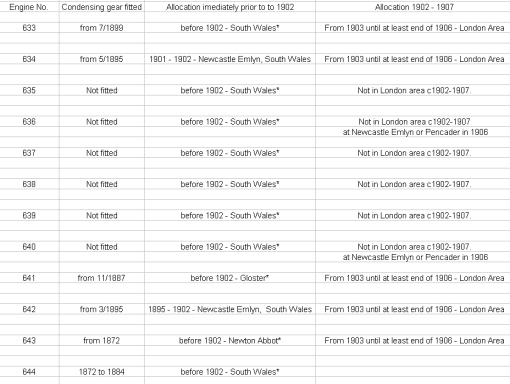I thought that this class, the final type of Great Western condensing locomotives to operate on the Metropolitan lines (until the introduction of the 97xx class in the 1930s), and therefore Basilica Fields, was going to be an easy one to deal with, after all, the books and articles I’ve seen detailing the GWR’s presence on the Metropolitan line write frugally, but broadly in agreement, upon their role on the goods service from Acton to Smithfield…but scratch the surface, and the reality is not quite so clear cut.
Built at Wolverhampton between November 1871 and April 1872, this class of twelve 0-6-0Ts were always Southern Division locos, and over the years some of the class were fitted with condensing equipment to work the Metropolitan lines.
What follows is a précis of the information in print:
They were the first six-coupled engines to be accepted for the Widened Lines, some twenty years in advance of the much larger and heavier Great Northern saddle tanks. Steam on the Widened Lines Vol.2 p.10. Geoff Goslin.
This implies the 633 were used on the Widened Lines from 1872 as the GNR 921 Series of saddle tanks were released to traffic in 1892. However, RCTS disagrees, and in its segment on the 2-4-0T Metro class, states:
The name of this class [the 2-4-0T Metro tanks] is derived from the engines’ association with the Metropolitan Railway, over which so many of them worked, they being the only GWR engines to do so during the latter part of the nineteenth century. RCTS The Locomotives of the Great Western Railway Part Six, p.F29.
With the absence of primary sources, if I had to choose between the two I’d plump for RCTS, although the Society’s publications are not infallible. However things now begin to get murky as RCTS also states:
Those with condensers were stationed in the London area for working over the Metropolitan line, whilst the non-condensing engines were mostly in South Wales, in the Neath Division. RCTS The Locomotives of the Great Western Railway Part Five, p.E34.
Condensing apparatus was fitted to 643/4 as built, but was removed from the latter in September 1884. RCTS The Locomotives of the Great Western Railway Part Five, p.E34.
There are discrepancies in the accounts of those fitted with condensers at this period, but it is fairly certain that Nos.633/4/41/42/43 were so fitted when rebuilt or shortly afterwards and remained so. RCTS The Locomotives of the Great Western Railway Part Five, p.E34.
The condensing engines remained without cabs until withdrawn in 1933-4. RCTS The Locomotives of the Great Western Railway Part Five, p.E34.
643 had always been a condensing engine. RCTS The Locomotives of the Great Western Railway Part Five, p.E34.
The implication of these quotes being that those fitted with condensers were allocated to the London Division only, all such locos being cabless for working through the Metropolitan tunnels, and those allocated to South Wales were fitted with cabs and did not carry condensers. However…
Surviving GWR Loco Allocation Registers only go back as far as 1902 (it has been suggested that possibly the 1902 one was the first such Register), and at the beginning of that year it is recorded that not one of the 633 class was allocated to the London Division, and (it would appear, if the RCTS opinion on the matter is to be believed) several of those in Wales were condenser fitted! Graham Beare saved me from too munching my way though too much paracetamol by sending the information in the following table (sorry for the slightly blurry image, please click for a clearer version), which collates info from both RCTS and the Register, followed by a suggestion as to which locos would be appropriate for Basilica Fields, post-1902:
N.B. * period of allocation indeterminate.
Graham writes:
In this instance, London Area means that an engine has been recorded as allocated to a shed within the London Division, examples noted include:- Paddington, Southall, Staines, Slough, Henley-on-Thames, Aylesbury, Watlington…. as far as I can see, there was no allocation to Reading, Didcot, Oxford. From this information, I suggest that the most likely candidates for your needs are 641, 642 and 643 which were Southall engines for most of the period from 1902 to 1906 and the most likely to be in charge of services over the widened lines.
The Registers are in the National Archive, and the 1902 Register can be found at RAIL 254 / 60. I’d like to thank John Lewis at this point for supplying digital copies of the relevant pages via Graham.
The photo of 642 is irresistible, and places it in London in pre-1906 livery, so spot on for the later period of Basilica Fields.
I’ve an old Mega (ex-Gateneal) kit of the 633 class, but I suspect that most of it will be binned – not necessarily because of any fault in the kit itself (though it is verybasic compared to modern offerings), but because it represents a much later version of the locos with different side tanks and enclosed cabs, and scratchbuilding looks increasingly likely.


May 21, 2010 at 5:55 pm
To quote.. “they being the only GWR engines to do so during the latter part of the nineteenth century.. “. I am not aware of what the RCTS would have considered to be ‘the latter part’ so maybe one can read the texts as… the 633 condensing engines were built for use on the Met. Rly. lines… and were not so used after circa 1880 (say) – now that concept would resolve the conflict over usage in the 19th century. What might the Loco Cmttee. Minutes have recorded about the corresponding Lot for the 633 class?
Adrian, the engine allocation registers do not record which engines are fitted with condensing gear. Your paragraph about the 1902 register can be read as if the register recorded engines as being in South Wales and as being condensing engines. What you and I noticed here was that the engines which the RCTS suggested were fitted with condensing gear in the early years of the twentieth century were recorded in the 1902 register as being in South / West Wales.
regards, Graham
December 9, 2010 at 2:22 pm
Just a belated note of thanks for bringing these details onto the web and into the light. The 633s are a favourite class of mine, especially around this time, so this info is very much appreciated.
August 2, 2012 at 2:21 pm
Although this class could I suppose come under the generic title of ‘Metro’, that name is usually now reserved for the 2-4-0Ts. The condensing 633s were more commonly referred to as ‘Tunnel motors’. (Source: Great Western Engine Sheds, Vol 1, London Division, Wild Swan Publications.)
August 10, 2012 at 1:36 pm
Thanks for your comments Russ. I don’t recall having seen a moniker for the 633s before, so thanks for enlightening me with the sobriquet ‘Tunnel Motors’. I really must get hold of a copy of the London Division Engine shed book.